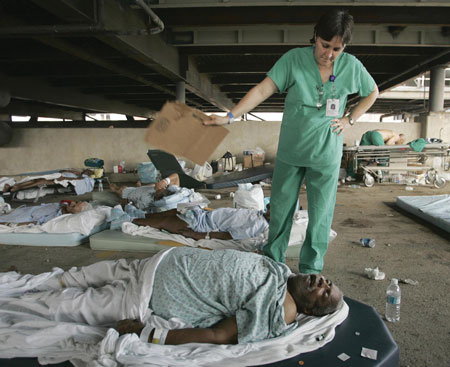| Inside a Washington insider | Teen alum amazes | The singing cancer crusader |
| Home Forethought President's Message Campus Buzz Feature Stories Re:Search The Score Alum News Yesteryear | ||
My introduction to Katrina came Thursday, Sept. 1, three days after the hurricane hit. Reporter Sudeep Reddy and I boarded a private plane to Hattiesburg, Miss., then continued to New Orleans by helicopter to cover the mass evacuations from Memorial Medical Center.
|
|
Like most, I watched on television the first few days of the aftermath and the horrific images of people trapped on rooftops in a city submerged. Flying over New Orleans, I was amazed at how much of it was under water. In the distance, Memorial rose a dozen stories above the water with people scampering onto the helipad to load patients on Coast Guard, Army Blackhawk and commercial helicopters.
We landed and I made a few images of patients being placed on the helicopter we had just vacated. Making my way down the steel staircase leading to the parking garage, I saw what would be my most storytelling photograph that day. An exhausted nurse stood over a half-dozen patients. Equipped only with a piece of cardboard, she fanned them one at a time.
 Memorial had become the anti-hospital: not sterile, not
organized, no technology, no medicine. And in these awful circumstances, there
was Mary Jo D’Amico, trying to provide comfort to her patients.
Memorial had become the anti-hospital: not sterile, not
organized, no technology, no medicine. And in these awful circumstances, there
was Mary Jo D’Amico, trying to provide comfort to her patients.
Months later, reports would surface of a doctor and two nurses euthanizing patients at Memorial. Maybe it happened. Maybe it did not. What I know is what I saw. Supremely stressed doctors, nurses, technicians, cooks and housekeeping staff toiled as one in sweltering heat and with little food and water to care for the patients and each other the best they could. Titles and seniority disappeared in a passionate effort to get the job done.
– Brad Loper
| Archives
| Alumni Association |
Giving to UT Arlington | UT
Arlington Home Copyright © 2006 UT Arlington Magazine. All rights reserved. |

 Brad Loper, The Dallas Morning
News
Brad Loper, The Dallas Morning
News